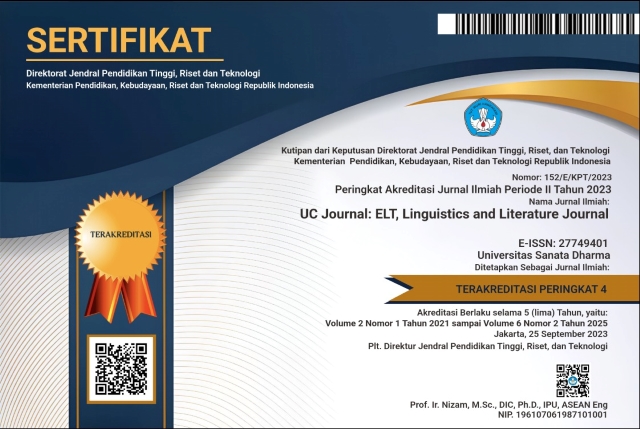LANGUAGE STYLES OF IPHONE ADVERTISEMENT SLOGANS
(1) Sanata Dharma University
(*) Corresponding Author
Abstract
There were two research problems addressed in this research. The first was to classify and analyze lexical and syntactic features that were contained in iPhone advertisement slogans. The second was to find out what characterizes the uses of lexical and syntactic features in iPhone advertisement slogans. The data were taken from an online iPhone advertisement slogan from the second version to the latest iPhone version recently. This research used a document analysis method and was categorized as qualitative and quantitative research. After classifying and analyzing the data, the researcher calculated the frequency to identity the top three mostly employ in lexical and syntactic features used in iPhone advertisement slogans. The results of the research were there are seven lexical features and seven syntactic features employed in iPhone advertisement slogans and the most three top dominant lexical features are simple vocabulary with 38.4%, hyperbole 21.1%, and potency with 19.2%. The top three commonly used syntactic features are short sentences with 23.5%, present tense with 19.6%, and long noun phrases with 13.7%. Those language styles are used to grab the customers attention.
Keywords
Full Text:
PDFReferences
Adyaningtyas, F. D. (2013). An analysis of word formation used in Pepsi and Coca-Cola advertisements published in United States from 1950 until 2012 (Doctoral dissertation, Thesis. English Language Education Study Program, Department of Language and Arts Education, Faculty of Teachers Training and Education, Sanata Dharma University).
Borchers, T.A. (2005). Persuasion in the media age. (2nded). New York: McGraw-Hill.
Bovee, C. L., & Arens, W. F. (1986). Contemporary Advertising, Homewood, IL: Richard D. Irwin. Inc., 1982BoveeContemporary Advertising1982.
De Beaugrande, R. A., & Dressler, W. U. (1981). Introduction to text linguistics (Vol. 1). London: Longman.
Fasold, R. & Jeff, C. (2006).An introduction to language in linguistics. Cambridge:Cambridge University Press.
Fromkin, V., Rodman, R., & Hyams, N. (2003). In ?ntroduction to language 7th edition. Boston, Mass.: Thomson and Heinle.
Gilson, C. &Berkman, H. (1986). Advertising, concept and trategies. Blacklick. OH: McGraw Hill College.
Goddard, A. (2002). The language of advertising.(2nded.). New York: Routledge.
Grey, D. (2008). Language in use. Cambridge: Cambridge University Press.
Keegan, W. J. (2003). Manajemen pemasaran global (; A. Sindoro and T. S. Tarigran, Trans). Jakarta: Gramedia.(Original work published 1995).
Kusumawardhani, S. D. A. R. (2014). Language Features of the Slogans on Cheetos Snacks in 1970s-2013. Undergraduate Thesis. Yogyakarta: Department of English Letters, Sanata Dharma University.
Leech, G. N.(1972). English in advertising: A linguistic study of advertising in Great Britain (English Language Series).
Madden, F. (2002). Exploring Poetry. London: Longman.
Naggy, S &Hesse-Biber. (2010). Mixed method research: Merging theory with practice. New York: The Guilford Press.
Potter, W.J. (1996). An analysis of thinking and research about qualitative methods. London. Routledge.
Quirk, R., Greenbaum., S., & Leech, G. (1972). A grammar of English. London: Longman Group Ltd.
Simpson, P. (2004). Stylistics: A resource book for students. New York: Routledge.
Setiastuti, C. (2011). A stylistic study on McDonalds slogan during 1960s-2008. Universitas Sanata Dharma.
Taylor, A. (1986). Communicating. Upper Saddle River, NJ: Prentice Hall.
Tsang, M. M., Ho, S. C., & Liang, T. P. (2004). Consumer attitudes toward mobile advertising: An empirical study. International Journal of Electronic Commerce, 8(3), 65-78.
Verdonk, P. (2002). Stylistics. Oxford: Oxford University Press.
Whittier, C. (1955). Creative advertising. New York: Henry Holt and company.
DOI: https://doi.org/10.24071/uc.v1i2.2960
Refbacks
- There are currently no refbacks.
Copyright (c) 2020 Rozalina Rozalina

This work is licensed under a Creative Commons Attribution-ShareAlike 4.0 International License.
UC Journal is indexed in:
UC Journal Sinta 4 Certificate (S4 = Level 4)
We would like to inform you that UC Journal: ELT, Linguistics and Literature Journal, or UC Journal has been nationally accredited Sinta 4 by the Ministry of Education, Culture, Research and Technology of the Republic of Indonesia based on the decree No. Surat Keputusan 152/E/KPT/2023. Validity for 5 years: Vol 2 No 1, 2021 till Vol 6 No 2, 2025
DOI: https://doi.org/10.24071/uc
e-ISSN (validity starting Vol 1, No 2, November 2020): 2774-9401

This work is licensed under CC BY-SA.
Creative Commons Attribution-ShareAlike 4.0 International License
 UC Journal: ELT, Linguistics and Literature Journal, a scientific peer-reviewed journal, was established in 20 May 2020 and is published twice a year, namely in May and November, by the English Language Education Study Programme (S1/Sarjana PBI) in collaboration with the English Education Master's Programme (S2/Magister PBI) of Sanata Dharma University, Yogyakarta, Indonesia.
UC Journal: ELT, Linguistics and Literature Journal, a scientific peer-reviewed journal, was established in 20 May 2020 and is published twice a year, namely in May and November, by the English Language Education Study Programme (S1/Sarjana PBI) in collaboration with the English Education Master's Programme (S2/Magister PBI) of Sanata Dharma University, Yogyakarta, Indonesia.














